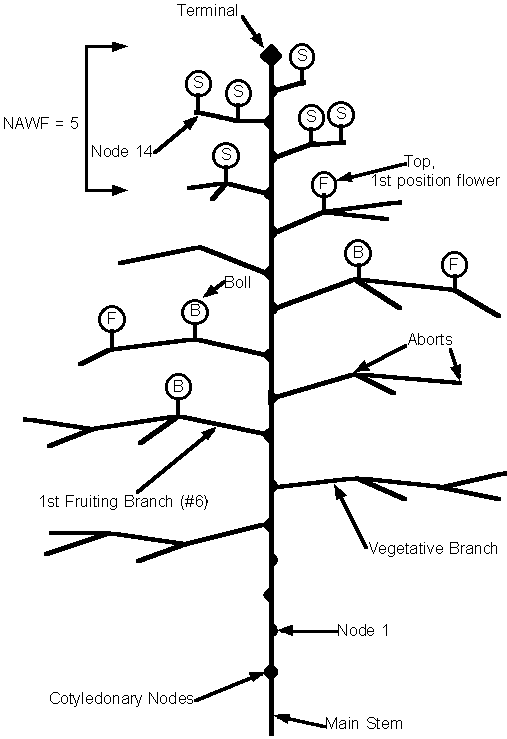Identifying the Agronomic Point of Diminishing Returns for Irrigated Cotton
by Jeffrey C. Silvertooth,
Extension Agronomist - Cotton
Proper timing of the final irrigation is a critical factor in determining lint yield, crop quality, and overall profits for a field. Every cotton field has a point of diminishing returns, a time when further irrigation and production inputs do not increase yields substantially or improve quality. Accurately predicting when this point occurs is particularly important in regions where the season is long enough to support a top-crop, or second fruiting cycle. For many fields, the point of diminishing returns occurs close to the cut-out phase of crop development. Therefore, it is important to watch for the progression of the crop towards, and into cut-out.
The number of nodes above the top, first position flower (NAWF) provides an easy and reliable estimate of crop maturity and cut-out (Figure 1). Generally, as the NAWF becomes 5 or less, the crop is progressing directly into cut-out. Timing of cut-out can also be estimated by tracking heat units accumulated after planting (HUAP, 86/55° F thresholds). Common ranges in HUAP for cut-out to occur are: 2,000 - 2,700 for short season; 2,300 - 3,000 for medium; and 2,500 - 3,200 for full season varieties. The range in HUAP to expect cut-out is due to a number of factors including the variety, the position of the first fruiting branch, fruit retention levels, crop stresses, etc..
Cut-out is a good time to assess the general crop condition, current pest pressures, and the potential return on pushing the crop into a second fruiting cycle for harvest of a top-crop. Three factors must be considered when making this decision.
- First, recent research in Arizona has shown that if fruit retention is greater than about 45% at cut-out (counting the first two fruiting sites on each fruiting branch) the plant will produce some additional yield, but usually will not add substantial yield through the development of a top-crop. Accordingly, in most cases, the greater the fruit load the plant has going into cut-out, the lower the potential for the crop to produce a large top-crop.
- Second, if a more indeterminate (full season) variety is being grown, the grower has a greater chance of pushing the crop on towards a top-crop for significant yield improvements. If the variety is a medium or short season type, top-crop potential is more limited.
- And third, optimum weather conditions (dry and warm) will also be needed in the late-season to realize any additional yield potential from the plant in a second fruiting cycle. A bloom requires about 600 heat units (HU) to develop into a full-sized, hard boll (fiber length development is complete). In July, August, and early September, the accumulation of 600 HU translates roughly to 21 days for most cotton growing areas of Arizona (Figure 2).
Yield potentials will vary from field to field and season to season. Therefore, each field needs a close evaluation to determine the last set of blooms that one intends realistically to take to harvest, irrespective of whether the crop is being terminated to mature the first cycle fruit load or going on for a top-crop. When that decision is made, the last set of blooms should be given at least 600 HU (about three weeks) of good plant-water conditions, or available soil moisture to complete their development to a hard, full-sized boll over that three week period. The number of irrigations that this will require will depend upon the soil texture (soil water holding capacity), the amount of water applied in an irrigation, and the soil water depletion rate.
Figure 1. Nodes above top white flower example (NAWF).
Figure 2. Boll development timeline
Issued in furtherance of Cooperative Extension work, acts of May 8 and June 30, 1914, in cooperation with the U.S. Department of Agriculture, James A. Christenson, Director Cooperative Extension, College of Agriculture and Life Sciences, The University of Arizona.
The University of Arizona is an equal opportunity, affirmative action institution. The University does not discriminate on the basis of race, color, religion, sex, national origin, age, disability, veteran status, or sexual orientation in its programs and activities.
Any products, services, or organizations that are
mentioned, shown, or indirectly implied in this web document do not imply
endorsement by The University of Arizona.
Information provided by Jeffrey C. Silvertooth, silver@ag.arizona.edu
Extension Agronomist - Cotton, College of Agriculture, The University of Arizona.
Material written May 1998.
Home | Cotton | Advisories
document located at: http://cals.arizona.edu/crops/cotton/cropmgt/diminish_returns.html
Copyright © 2001 University of Arizona,
College of Agriculture and Life Sciences
Webmaster: Al Fournier (acis@ag.arizona.edu)

